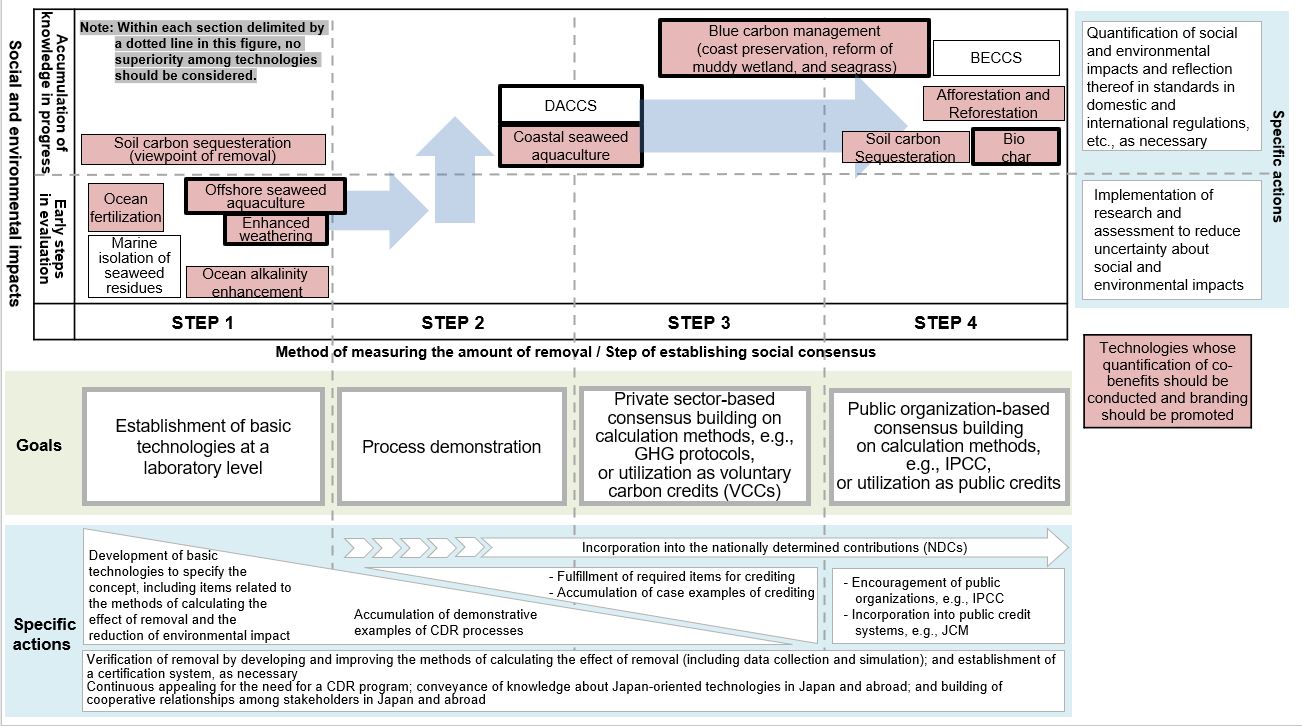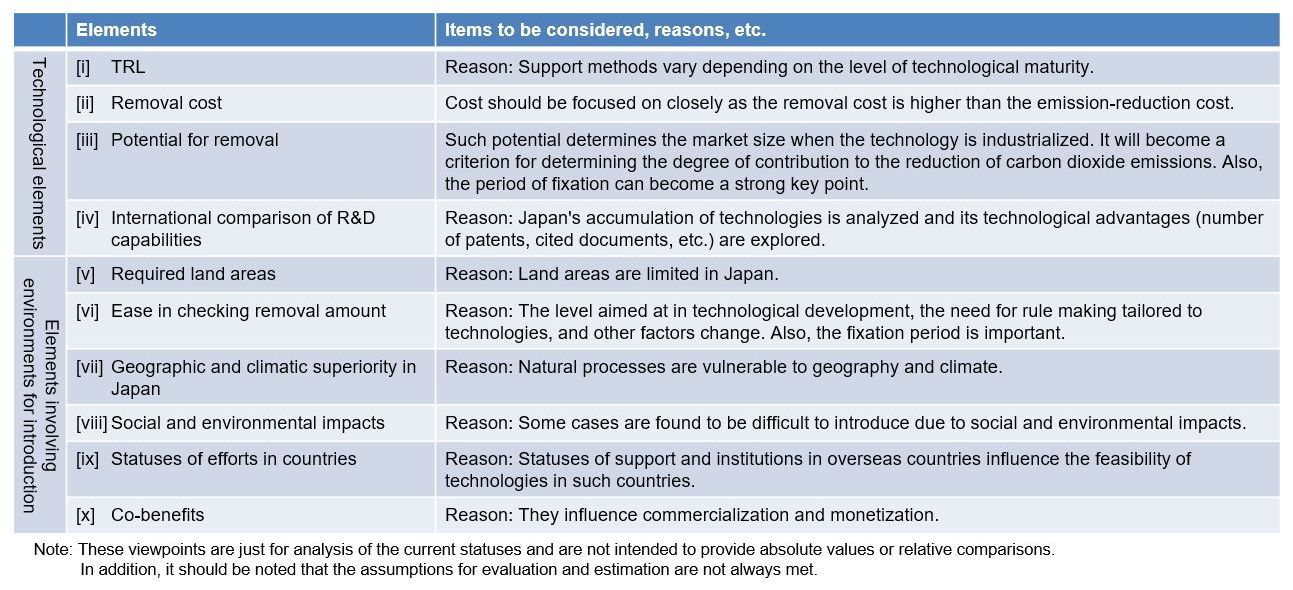- Home
- News Releases
- Back Issues
- June FY2023
- Future Directions Compiled for Social Implementation and Industrialization of Negative Emissions Technologies (NETs) Required for Achievement of Carbon Neutrality (CN) by 2050
Future Directions Compiled for Social Implementation and Industrialization of Negative Emissions Technologies (NETs) Required for Achievement of Carbon Neutrality (CN) by 2050
June 28, 2023
The achievement of carbon neutrality (CN) by 2050 requires carbon dioxide removal (CDR) programs for removing carbon dioxide from the air. To realize this, it is necessary to achieve social implementation and industrialization of negative emissions technologies (NETs) as early as possible. The Ministry of Economy, Trade and Industry (METI) started a series of meetings of “Study Group for Creating Markets of Negative Emissions Technologies” in March 2023, and it has compiled discussion results into a report. The report presents well-organized information, including trends in technological development and those in business involving NETs inside and outside of Japan and elements on which to focus in the industrialization of NETs, which are technologies that incur a higher cost than emissions reduction, and then it provides streamlined policies for creating a market for NETs, including future directions of each technology and rule-making.
1. Background
The achievement of CN by 2050 requires the removal of carbon dioxide from the air as a means for offsetting emissions from fields in which industries have unavoidable carbon dioxide emissions in the end even if they make maximum efforts for reduction (i.e., residual emissions). As global society needs to remove about 2 to 10 billion tons of carbon dioxide per year by 2050, mainly Western countries, such as the U.S., and European Commission and the UK, recently publicized one after another the need for CDR programs and their policies for future efforts. They have also started providing proactive policy-based support to expand the introduction and social implementation of CDR programs.
The achievement of CN by 2050 in Japan is considered to require a CDR program at the level of about several hundred million tons per year in order to offset about 50 to 240 million tons per year of residual emissions, an estimate that the industrial and transportation sectors may mainly emit. However, as the removal cost is higher than the reduction cost, it is difficult to expand the introduction of a CDR program among industries on a voluntary basis. Accordingly, it is important to start efforts for expanding NETs as soon as possible so as to ensure the achievement of CN.
To this end, METI started a series of meetings of the study group in March 2023, organized information, including trends in technological development and those in business involving NETs inside and outside of Japan and elements on which to focus in the industrialization of NETs, while also taking interviews with experts, related companies, and other stakeholders, and held discussions and review on policies for creating a market for NETs, including the future directions of each technology and rule-making. Following this, METI compiled discussion results into a report.
2. Overview of the report
(1) Analysis of current situations and future directions of NETs
Leading up to policies for creating a market for NETs, the study group analyzed the current situations of the respective technologies based on ten viewpoints in total (see the reference below) in terms of technologies, including cost and potential, and in terms of environments for introduction, including ease in checking removal amount. The study group also presented the future directions of each technology. Moreover, the study group focused on the “difficulty in ascertaining the effect of removal” as a unique feature of NETs, and based on this, it examined the steps to be aimed at, specific actions to be undertaken, and the positions of each technology, placing the following items at the core: “established and recognized methods for confirming the effect of removal” and “ascertained impact on society and the environment” as keys to the social implementation of NETs.


(2) Policies for creating a market for NETs
It is indispensable for the achievement of CN by 2050 to introduce a CDR program that offsets unavoidable carbon emissions (residual emissions). Nevertheless, as the removal cost is generally higher than the reduction cost, it is difficult to expand the introduction of a CDR program among industries and enlarge a market for NETs on a voluntary basis. Meanwhile, it is considered that an early launching of a CDR market would contribute to not only Japan’s achievement of its goal of emissions reduction but also to fortifying its competitiveness in technology as Japan’s advantage to gain a market that is sure to expand internationally in the future. For this purpose, it is necessary to create a CDR market with relatively higher value as early as possible.
The report presents well-organized information on the following points, aiming at the creation of a NETs market: [i] the need for discussions on government support at an early step in market creation on the basis of the current situation of discussions in Western countries, etc., [ii] the development of an environment for making use of carbon credits (carbon removal credits) so as to trade the values of CDR and expansion of the initial demand, [iii] the promotion of business models, including co-benefits (secondary values other than carbon dioxide removal) and awareness raising among consumers, and [iv] the establishment of a discussion framework to make rules necessary for gaining a market.
METI expects that the details of the report will be broadly shared among stakeholders and help to disseminate an understanding of the need for a CDR program and NETs, and also that discussion on them will continue in the public and private sectors, thereby achieving the industrialization of NETs and making a market for NETs more vital.
Related Materials
- Report: Study Group for Creating Markets of Negative Emissions Technologies (in Japanese)

- Reference: Study Group for Creating Markets of Negative Emissions Technologies (in Japanese)

- Summary: Study Group for Creating Markets of Negative Emissions Technologies (in Japanese)

Division in Charge
GX Investment Promotion Office, Industrial Science, Technology and Environment Policy Bureau, GX group